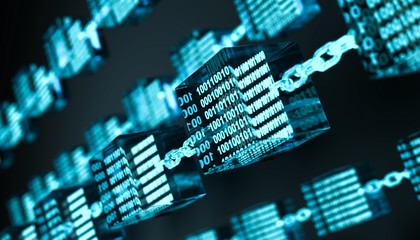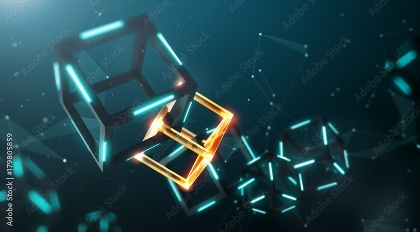 April and May 2024
April and May 2024
Blockchains
This edition of Ken’s Korner’s Newsletter covers April and May 2024.
Blockchains
What is a blockchain?
The short answer is a blockchain is a database. Most databases. Like SQL or Access, consist of a bunch of data on a computer hard drive. Unlike most databases the blockchain is shared. That is to say it does not reside in any one place. Instead, it is distributed to many locations on different nodes (computers) of a peer-to-peer network. Why would anyone want to do that?

The blockchain concept was first outlined in 1991 by Stuart Haber and Scott Stornetta. They wanted to implement a system where the document timestamps could not be altered. It was almost two decades after that with the launch of Bitcoin that the blockchain had its first “real world” application.
There are five basic types of blockchain networks:
- Public blockchain networks have no special permissions. Anyone can join and everyone has equal rights to read, edit and validate the blockchain. Public blockchains are primarily used to mine cryptocurrencies like Bitcoin, Ethereum and Litecoin.
- Private blockchain networks where a single organization controls who can access the network and what permissions they will have. They are not as fully decentralized as public blockchain networks due to the access restrictions. The digital currency exchange for Ripple is an example of a private blockchain network.
- Hybrid blockchain networks combine aspects of both private and public blockchain networks. Companies can set up private, permission-based systems alongside a public system. Smart contracts are used to allow public members to check if private transactions have been completed. For example, the bank could allow access to digital currency while keeping the bank owned currency private.
- Consortium blockchain networks are like private blockchain networks except a group of organizations maintain control of the system. The Global Shipping Business Network is a not-for-profit blockchain consortium for the shipping industry, their mission is to increase the collaboration between maritime shipping companies.
- Permissioned blockchains only allow authorized peers to participate in blockchain operations.
Many people equate blockchains with Bitcoin. While Bitcoin was the first large scale use of blockchain technology they are not the same thing. Bitcoin is a digital currency whereas blockchain technology is how it is generated and transacted. The two are tied together but there are many other uses for blockchain technology besides Bitcoin.
Key points:
- Decentralized blockchains are immutable. Once the data is entered it is irreversible.
- No single person has control over the data. Instead, all users collectively maintain control.
- While different types of data can be stored in a blockchain, the most common use has been as a ledger.
- Blockchain is a type of shared database that stores information in blocks linked together via cryptography.
Since no one person or entity has complete control of the data it is very difficult to alter the data. People use the term “immutable” to describe the inability to alter the data once it has been entered. That makes it much more secure than if the data was on one server under the control of auditors or other humans. They would cost money and could make errors.
A blockchain uses scripts or small programs that perform the tasks of entering and storing data much as a person would do with a conventional database. Since the blockchain is distributed many copies are saved on many machines in various locations. These copies all have to match for the data to be valid.
The blockchain collects data and enters it into a block, much like a cell in a spreadsheet. When the block is full an encryption algorithm creates a hexadecimal number called a hash. The hash is entered into the following block header and encrypted with other information in the block creating a series of blocks that are chained together.
Blockchains can trace their origins to crypto currencies. What started as the backbone of Bitcoin in 2009, later with Ethereum and others has become the cornerstone of trust and transparency for a wide variety of applications.
The Bitcoin Transaction Process
Transactions follow a specific process depending on the blockchain in question. For example, on Bitcoin’s blockchain when you initiate a transaction in your cryptocurrency wallet the transaction is sent to a “memory pool” where it is stored until it is picked up by a miner or validator. Here is an abbreviated description of the working of a Bitcoin transaction.
- First a new transaction is entered from a cryptocurrency wallet.
- The transaction is then transmitted to a network of computers located in various places around the world.
- The network of computers solves the equation to confirm the validity of the transaction.
- After the transaction has been confirmed as legitimate it is clustered together with other transactions into blocks./LI>
- The blocks are then chained together forming a permanent history of all transactions.
- The transaction is then complete.
Once it is entered into a block and the block fills up with transactions, that block is closed and encrypted using an algorithm. Then the mining begins.
NONCE, (Number used Once).
The entire network works simultaneously to “solve” the hash. Each one generates a random hash except for the “nonce” or number used once.
Each miner starts with a nonce of zero. That is added to the randomly generated hash. If that number isn’t equal to or less than the target hash an value of one is added to the nonce and a new hash is generated. This process continues until a miner generates a valid hash. That miner then wins the “race” and receives the “reward”.
When the block is closed the transaction is completed but it is not considered to be confirmed until at least five other blocks have been validated. Confirmation may take the network an hour to complete if the average is about ten minutes per bloc
Generating random hashes until a specific value is found is called “proof-of-work”. It takes a great deal of computational power to validate a hash which is why the Bitcoin network consumes so much power. The Bitcoin network alone consumes more energy than many small countries use annually.
Not all blockchains follow this process. The Ethereum network randomly chooses one validator from all the users with ether staked to validate blocks. Then the blocks are confirmed by the network. This is much faster and less energy intensive than the Bitcoin process.
Unless someone controls more than half or the nodes on the network and has a very good sense of timing. In such a case someone could alter the record and claim to have more Bitcoins than they truly possess. This is called a 51% attack because you need to control more than 50% of the network to make it work.
This explains the “arms race” between China, the US and a few others trying to mine and control the majority of Bitcoins. The total number of Bitcoins is finite. At some point the last Bitcoin will be mined. No one is sure when this will occur. As the number of “discovered” bitcoins grows the remaining Bitcoins become more difficult to find.
Timing would be very important in a 51% attack. By the time the hacker acts the network is likely to have moved beyond the block they were trying to alter. This is due to the fact that the rate these networks hash is extremely fast. The bitcoin network hashed at 348.1 exahasehes per second, (that is 18 zeros) on April 21, 2023. The hackers’ timing would have to be exquisite to successfully execute the attack.
Can you mine Bitcoins with your PC? Technically yes you can but you will be competing with operations that employ vast datacenters with a dedicated power plant to supply the enormous number of computers all mining at top speed.
Blockchains are transparent because the decentralized database can be viewed either with a personal node or a blockchain explorer that will allow anyone to see transactions as they occur. Each node has its own copy of the blockchain. In theory you can track a bitcoin wherever it goes. You cannot see the names of the owners of the wallets, but you can see the wallet’s address that was involved in the transaction. There are certain bitcoins that have been blacklisted because they were used in criminal activity sometime in the past. If authorities can identify the wallet, they may be able to claw back some of those coins.
However, this does not work for all blockchains. Monero XMR transactions are anonymous by default. The sender, receiver and the amount of the transaction are hidden through the use of three important technologies. Stealth Addresses, Ring Signatures and RingCT. While an observer might be able to see that activity is taking place, the longer they watch the more complex it becomes. Somewhat like an old-fashioned square dance. You start with one partner but by the time you are done it appears as though you have danced with everyone in the dance hall. This makes it very difficult to identify a specific transaction. People using Monero do not have to worry about tainted or blacklisted coins.
Because of the decentralized nature of blockchains all transactions can be viewed by either having a personal node or a blockchain explorer that allows anyone to see transactions occurring live. Each node has its own copy of the chain. And that copy gets updated as fresh blocks are confirmed and added. Since the blocks are encrypted only the person who is assigned an address can reveal their identity. So blockchain users can remain anonymous while preserving the transparency of the blockchain.
Not all blockchains are 100% impenetrable. They are distributed ledgers that use code to create the security level they have become famous for. If there are vulnerabilities in the coding they could be exploited.

Another feature of cryptocurrencies is the ability to “bank the unbankable”. For people in countries with unstable currencies or financial systems it offers a more stable currency and financial system. Many of the people in the “third world” have very little income. Often working for as little as five dollars per day. Traditional banking is not available to them because the financial system simply can’t deal with such small accounts. That is not a problem for cryptocurrencies. Since there is no central authority, the fees are much smaller. Many of these countries are war torn or have governments that lack any real identification infrastructure. But most of these people do have a smart phone and blockchains offer them a way to store and accumulate wealth.
Other uses for blockchains.
Banking and finance companies could benefit from integrating blockchains into their business operations more than most other industries. Banks an financial institutions usually operate during business hours. If you deposit a check late Friday afternoon the funds may not be in your account until the following Monday. Some transactions take up to three days to verify, even longer for international trades. With blockchains the banks also could exchange funds between banks more quickly and securely. The sums of these transactions can be quite large. Even if just for few days the money in transit can carry sizable costs and risks for these institutions.
Healthcare providers could use blockchains to store patients’ medical records. When a medical record is generated and signed it can be written into the blockchain. That would provide proof and confidence that the record cannot be changed. Personal health records could be stored with a private key so that only specific people would have access.
Property records are both burdensome and inefficient. If you have ever spent time at your local Recorder’s office or delt with real estate sales, you know that the process is not just costly and time consuming but prone to human error. In some countries there is no recorders office and proving ownership can be nearly impossible. Using blockchain technology could streamline the process and reduce the time and potential for errors
Supply chains are another place where blockchains could be a big help. The IBM Food Trust allows suppliers to record the origin of materials that they have purchased. This allows companies to verify the authenticity of their products and many common labels like “Organic”, “Natural”, “Local” and “Fair Trade”.
Another reason the food industry has been moving to the blockchain is that it can also show what route the product took from farm to table and what other items it might have encountered on its journey. Problems like e-coli outbreaks could be traced much faster and the infection could be mitigated using blockchains.
Blockchains in the supply chain is not limited to just the food industry. Manufactures can use it to track each component from mine to delivery of the finished product. When the finished product has thousands, even tens of thousands of individual parts from many different suppliers from all over the world being able to follow the path the parts took can simplify the process and make quality control much more effective.
Voting, this is one place I would really like to see blockchains being used. Voting with blockchains has the potential to eliminate voter fraud and boost voter turnout. A small-scale test was conducted in November 2018 with the midterm elections in West Virginia.
Using blockchain technology for voting would make it nearly impossible to tamper with votes. It would also help the transparency of the process, reduce the number of personnel needed to conduct an election and provide officials with nearly instant results. It would eliminate the need for recounts and any real concern that fraud might have taken place.
Energy companies use blockchains technology to create peer-to-peer energy trading platforms and streamline access to renewable energy sources.
Some energy companies have created a blockchain based trading platform for the sale of electricity between individuals. Homeowners with solar panels can sell their excess electricity to their neighbors.
Using blockchain based crowd funding initiatives users can sponsor and own solar panels in communities that lack energy access. The sponsors might even receive rent from these communities once the solar collectors are built.
Media and entertainment companies use blockchain systems to manage copyright data. This is crucial for the fair compensation of artists. It can take many transactions to record the sale or the transfer of copyrighted material. Sony Music Entertainment uses blockchain services to make digital rights management more efficient. They have been successful at reducing the costs of copyright processing.
Despite the complexity, blockchain’s potential as a decentralized form of record keeping is almost without limit. Starting with greater accuracy, security and user privacy, not to mention lower processing fees and fewer errors, it is very likely that blockchains will see use in many more applications than the few examples I have listed here.

Pros and Cons of Blockchains
Advantages of Blockchains:
- Transparent technology
- Improved accuracy by removing the human element in verification.
- Reduced costs by eliminating third party verification.
- Decentralization makes it harder to tamper with.
- Transactions are secure, private and efficient.
- Provides a secure alternative means of banking for people in locations where conventional brick and mortar banks are not available.
Drawbacks of Blockchains:
- Technology costs. While the blockchain can save users money on fees the computational power is far from free.
- Speed and data inefficiency. Bitcoin is a classic case of the inefficiencies of blockchains. It takes the network about ten minutes to add a new block to the blockchain. While other blockchains perform a little better, VISA can process over 65,000 transactions per second.
- Illegal activity has given many of the digital currency a black eye. Confidentiality works both ways and criminals on the dark web take advantage of that. Of course, it isn’t like criminals never use the US dollar in their illicit dealings.
- Regulation remains unclear. At this time, it would be very difficult, probably impossible to end something like Bitcoin. Theoretically governments could make it illegal to own cryptocurrencies or participate in their networks. China banned crypto trading and mining in 2021 but it still continues in rural areas through grey market operators
Many practical and advantageous applications for blockchain technology being currently implemented around the world and more joining the movement every day. The blockchain technology is finally making a name for itself after all. This is in no small part due to the success of Bitcoin and other cryptocurrencies. It has become a buzzword on the tongue of every investor in the country and it has the potential to make business and government operations more accurate, efficient, secure and cheaper with fewer middlemen.
As we scramble into the third decade of blockchain technology it is no longer a question of if the legacy companies will get on board. It is only a question of when.
If you know someone that you think would enjoy this newsletter, share it with them and ask them to join using the link at the bottom of the page.
And remember — always back it up!